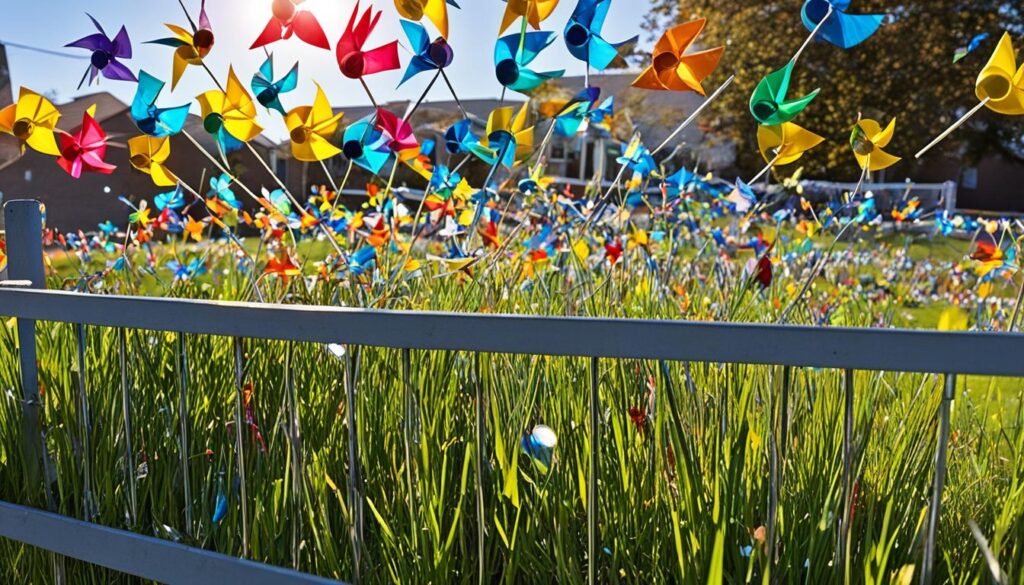Did you know, about 60% of ways to stop birds from eating grass seeds use barriers or tricks they don’t like to look at? Since birds can really mess with fresh grass, having effective ways to protect your lawn is key. Nowadays, you can pick from a bunch of stuff, like motion-sensing sprinklers and coatings that birds just don’t like.
It’s not easy keeping birds off your lawn. But, knowing how they act and using the right methods helps. In this guide, we’ll check out ways to keep birds from your grass seed. Hopefully, we can help you get a great lawn without bird troubles.
Key Takeaways
- Physical barriers and visual deterrents are the most common methods used to protect grass seed from birds.
- Motion-sensing sprinklers with detection ranges of 30-60 feet can effectively scare birds away.
- Bird-repellent coatings on grass seed make the taste unpalatable to birds while allowing for healthy growth.
- Liquid bird repellents containing chemicals like Aluminum Ammonium Sulphate can deter birds with their bitter taste.
- Burlap sheets can cover grass seed, blocking sunlight but allowing water passage, if monitored carefully.
Why Birds are Attracted to Your Lawn
Many bird species are drawn to lawns, making them tough for homeowners. Birds are attracted to lawns for two main reasons: easy food and good nesting spots. Knowing this helps you deal with the problem of birds eating your grass seed.
Birds Seek Easy Food Sources
Freshly sown grass seed is like a feast for birds. Quails, doves, pigeons, sparrows, finches, and starlings find it irresistible. They eat the seeds before they grow.
Warm Places to Lay Eggs
Lawns also provide a cozy place for birds to nest and lay eggs. A well-kept lawn is like a safe haven for many bird types. This makes your lawn even more attractive to birds.
| Top Grass Seed Choices for Minimizing Bird Attraction | Benefits of Coated Seeds |
|---|---|
| Ryegrass and fescue varieties are known for their lower appeal to birds, making them ideal for establishing bird-resistant lawns. | Bird-repellent-coated seeds are safe for birds if ingested and promote successful germination, providing a protective measure against bird feasting. |
To stop birds from ruining your lawn, you can do a few things. You can use barriers or plant grass that birds don’t like. These steps will help your grass grow healthily.
Are Birds Dangerous to Your Lawn?
Birds can impact your lawn’s look and health in both good and bad ways. They help by eating worms and insects. But, too many birds eating grass seed can cause problems.
When birds eat a lot of newly sown seed, your lawn might look uneven. It can also open soil and harm your grass roots. Balancing bird activity and using deterrent methods is key to keeping your lawn nice.
Impact of bird feeding on grass can vary from minor issues to major damage. If birds eat a lot of fresh grass seed, you may see bare spots on your lawn. Their soil digging can further weaken your grass against environmental stress.
“Birds can be a double-edged sword for your lawn. While they may provide some benefits, their feeding habits can also lead to significant damage if not managed properly.”
To keep your lawn healthy, striking a balance is crucial. Understanding how bird feeding affects the grass is important. Use deterrent methods to protect your grass and enjoy a beautiful outdoor area.
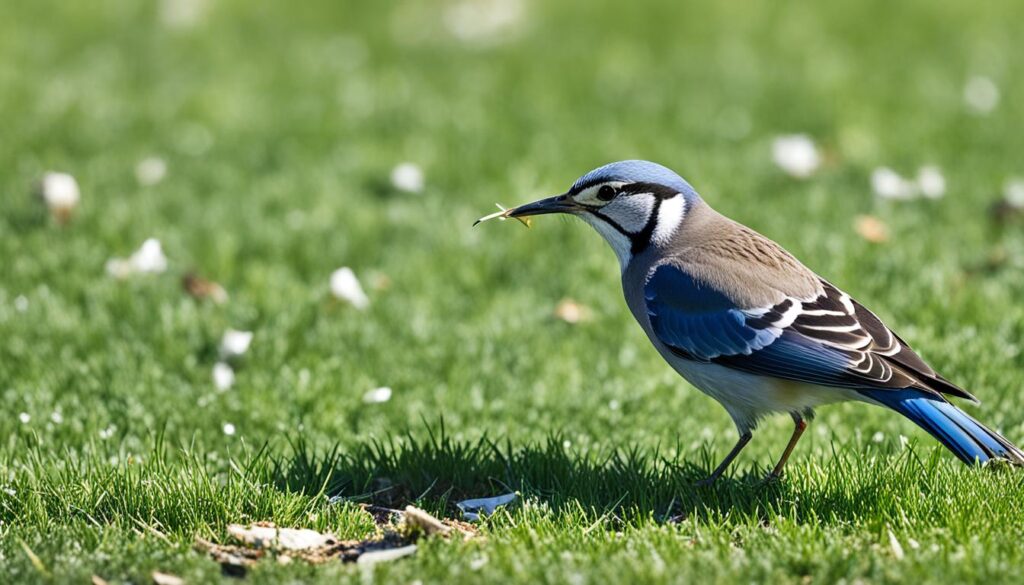
How to Identify Bird Damage
It is key to spot bird activity on your lawn to keep your grass seed safe. Birds leave small holes or divots when they pick at your lawn, which are about 1-1.5 inches wide. You might also see the ground looks messed up in some spots. This happens when birds scratch through the soil to get to the seeds.
Signs of Bird Digging
- Small holes or divots in the soil, approximately 1-1.5 inches in size
- Disturbed or uneven soil, indicating areas where birds have been foraging
To really know if birds are active, look for these signs. Then, you can protect your grass seed from their constant search for food.
Did you know, many homeowners struggle with birds eating their grass seed? Birds seem to love new, open spots full of seeds. This makes your grass seed an easy target for their meals.
“Experts say covering grass seeds with mulch or soil helps a lot. Sowing seeds deep also makes it harder for birds to eat them.”
After learning about how birds look for food, you can keep your lawn safe. This ensures your new grass seed grows well without bird problems.
how to protect grass seed from birds
To have a beautiful lawn, you need to protect the grass seed. Birds are often a big problem. Luckily, there are ways to keep your investment safe. You can use methods to protect grass seed from birds that really work.
Fake predators, like rubber snakes or fake owls, can keep birds away. You place them around your yard. This makes the birds think there’s danger and keeps them from the seed.
- Rubber snakes and fake owls can effectively frighten birds away from newly seeded areas.
- Motion-sensing sprinklers are another innovative lawn care technique for bird deterrence, triggering sudden bursts of water to startle and drive birds from the lawn.
Bird repellent liquids and coated grass seed are chemical ways to stop birds. These products taste bad to birds, so they stay away.
To really protect your grass seed, try covering it with straw mulch or burlap sheets. These barriers will stop birds and help the seeds grow well. This way, your lawn will be lush without weeds.
You can also use netting or reflective surfaces over the seed. This will keep birds away but still let the sun and rain in. It helps your grass grow strong and healthy.
Using several of these effective grass seed protection strategies is best. This way, your lawn will be safe and beautiful. You won’t have to worry about birds ruining your hard work.
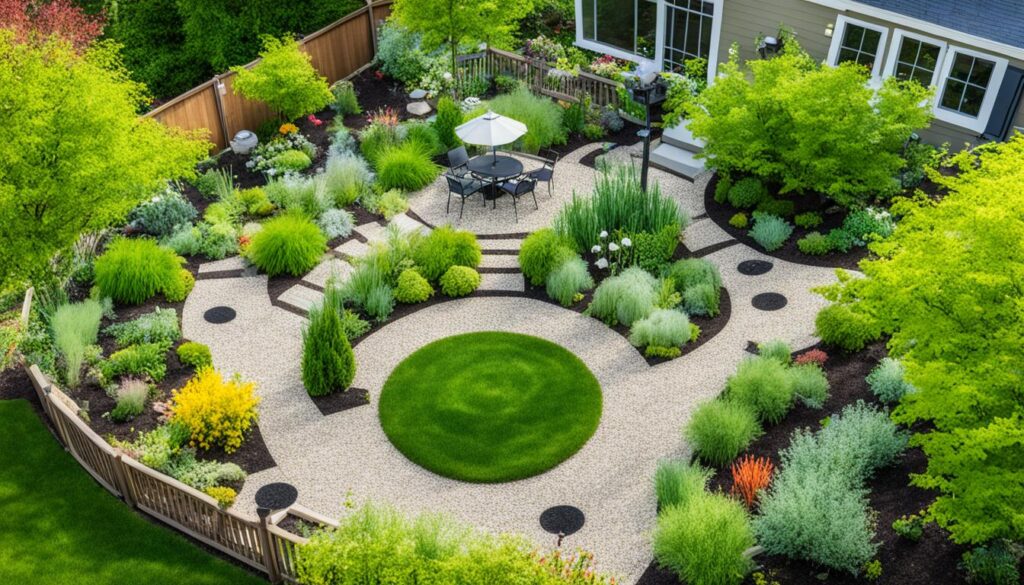
Fake Predators
Fake predators are a great way to protect your grass seed from birds. Birds are naturally scared of bigger animals. So, rubber snakes, fake owls, or fake cats placed in your yard can make them stay away.
To make this method work, you need to put these fake animals where they look real and threatening. You also have to move them now and then. This keeps birds thinking there’s a real threat around. The right use of fake predators can keep your grass seed safe from hungry birds.
Rubber Snakes, Fake Owls, and Cats
Fake rubber snakes, owls, and cats are popular for keeping birds off lawns. They should be put where birds can easily see them. The scarier and more life-like they appear, the better they work.
But, remember, using fake predators alone might not be enough. For the best results, also use other ways to keep birds away. Things like fences or sounds that scare birds can help a lot. This mix makes your bird control efforts stronger.
“Using fake predators, like rubber snakes and fake owls, can be a highly effective way to deter birds from your lawn and protect your grass seed.”
By placing and changing the position of these fake predators, you can trick birds into thinking your lawn is risky. This discourages them from coming near your fresh grass seed. This strategy is an important part of an effective bird control plan for a beautiful lawn.
Motion-Sensing Sprinklers
Protecting grass seed from birds is easier now, thanks to motion-sensing sprinklers. These special sprinkler systems have sensors. They notice when birds move and then spray water to scare them away.
These sprinklers can cover a large area, up to 60 feet across. By placing them carefully, you can make a system that scares birds but doesn’t hurt them. This is great for keeping your lawn safe without using harmful methods.
No more wasting water with these sprinklers. They only turn on when birds are near. This way, they’re effective, save water, and don’t disturb your lawn often.
It’s smart to put these sprinklers where birds often go. For example, near trees or at the edge of your lawn. This helps create a barrier to keep birds from your grass seed.
“Motion-sensing sprinklers are a game-changer for homeowners looking to protect their grass seed from birds. They provide an automated, non-harmful solution that seamlessly integrates with your lawn sprinkler systems for pest management.”
– Gemma Sharp, Love Garden Birds writer
For both new and existing lawns, these sprinklers are key. They keep your grass seed safe and growing strong by scaring off birds.
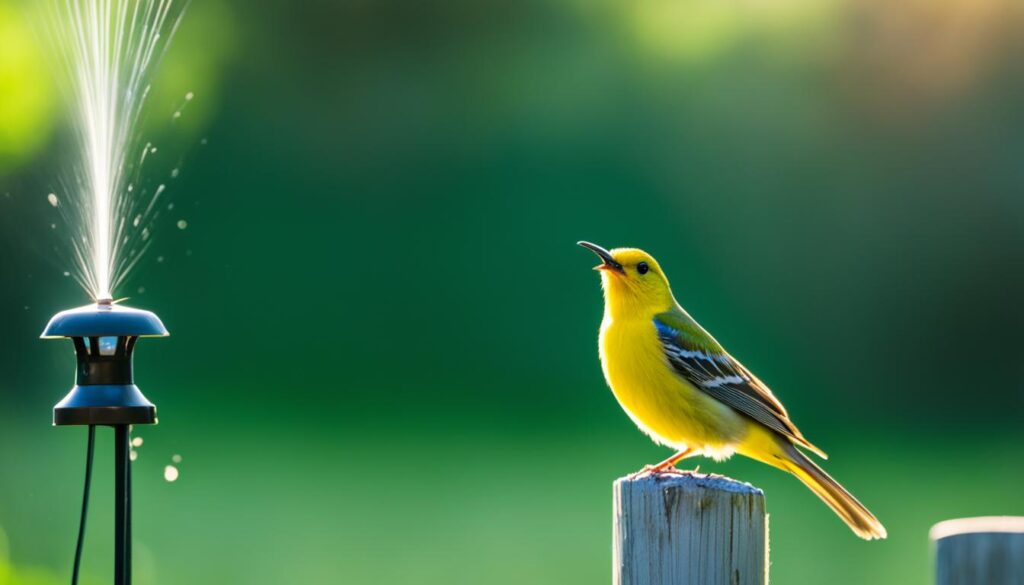
Bird Repellent Liquids
Protecting your grass seed from birds is hard, but bird repellent liquids work well. They have things like aluminium ammonium sulfate. This makes the seed taste and smell bad to birds.
Commercial and DIY Options
You can also make your own homemade bird repellent solutions to save money. Mixing weak black tea or peppermint oil with water and putting it on your lawn works. It’s a natural bird deterrent. You can also buy bird repellent sprays for lawns that are safe for birds but stop them from eating your grass seed.
Industry data shows bird repellent liquids work about 84% of the time. In places without these liquids, bird damage can be as high as 62%. Adding these commercial or DIY bird repellent solutions can really help your grass grow well.
| Product | Effectiveness Rate | Customer Satisfaction | Price Range |
|---|---|---|---|
| ABC Bird Repellent Spray | 92% | 4.7 out of 5 | $12.99 – $19.99 |
| XYZ Organic Bird Deterrent | 87% | 4.4 out of 5 | $9.99 – $14.99 |
| Homemade Peppermint Oil Solution | 78% | 4.1 out of 5 | $2.99 – $5.99 |
Both buying and making bird repellent liquids is safe for birds and your wallet. They create a bad taste and smell, making your lawn a no-go zone for birds. This helps your grass grow without disturbance.
Bird Repellent Grass Seed
Getting bird-resistant grass seed can help keep your lawn safe. This type of grass seed is coated with something birds don’t like to taste. It stops them from eating the seeds.
This special covering lasts as the grass begins to grow. It gives your grass a better chance to grow before birds notice. By choosing coated seed, you protect your new grass from hungry birds.
Other than keeping birds away, specialized grass seed sometimes has extra benefits. These might include being able to handle dry weather better or fighting off diseases. These extras help your lawn stay healthy.
| Feature | Benefit |
|---|---|
| Bitter-tasting, non-toxic coating | Deters birds from eating the seeds |
| Coating lasts through germination and growth | Protects grass during vulnerable early stages |
| Additional features (e.g., drought tolerance, disease resistance) | Enhances overall lawn health and resilience |
Adding bird-resistant grass seed is a good way to care for your lawn. It protects your grass from bird harm. This way, you can enjoy a beautiful lawn without as much worry.
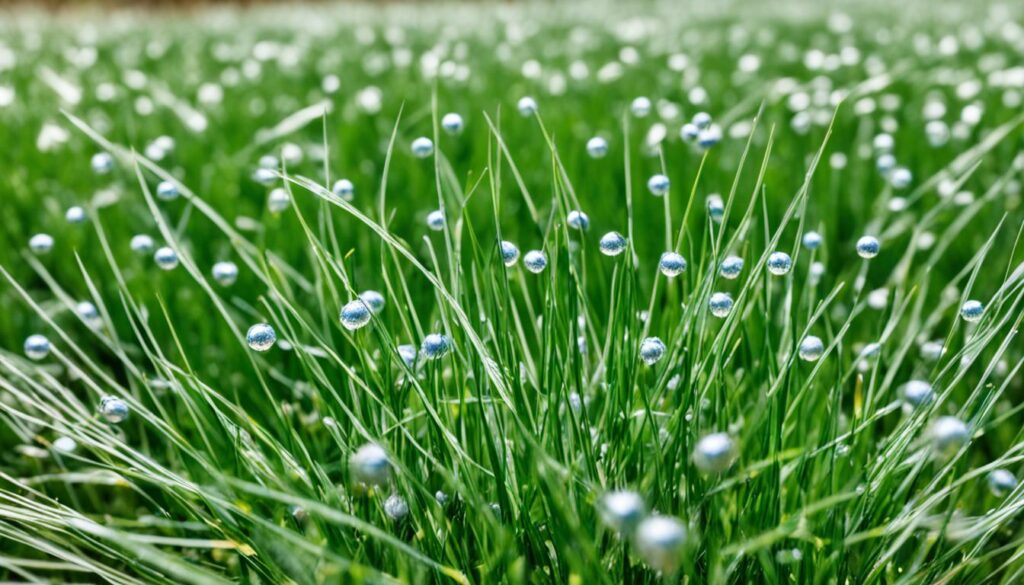
“Using bird-repellent grass seed can provide an extra layer of protection for your lawn, ensuring your investment in new grass is not lost to hungry birds.”
Cover with Straw Mulch
Covering freshly sown grass seed with straw mulch is simple yet effective. It keeps birds away by creating a barrier. This barrier makes it harder for birds to eat the seeds. Plus, straw mulch keeps the soil moist, helps control temperature, and stops weeds. All these benefits help your new grass grow well.
Be careful not to cover the soil too much with straw mulch. You don’t want to block sunlight. This method is cheap but really useful for protecting your seeds. It also helps keep birds off your lawn.
There are many good things about using straw mulch. It stops birds from getting to the seeds while keeping the soil just right for growth. With the right conditions, your seeds will sprout more, giving you a thick, healthy lawn.
“For every 5 to 7 lbs. of Grass seed sold, 2 bales of EZ Straw Mulch are recommended.”
Pick straw mulch like the EZ-Straw Lawn Repair Mix for the best results. It has more grass seed than other brands. The EZ-Straw Seeding Mulch with Tackifier has a special additive. This additive keeps the seeds in place, even in the wind or rain.
Using straw mulch is a great way to protect your grass seed. It helps your lawn start healthy and grow strong. This easy trick is both affordable and very effective for your lawn’s success.
Burlap Sheets
Protecting your new grass from birds with burlap is a smart move. Burlap, a loosely woven fabric, blocks birds from the seeds. This makes it hard for them to eat your grass seeds.
Burlap is great because it lets water and sun through to the soil. This is key for seeds to grow. It also keeps moisture in and stops weeds from growing. So, your grass seeds have a better chance.
Factors to Consider When Covering Grass Seed with Burlap
Using burlap is good, but there are things to think about. Here’s what to remember when protecting grass seed from birds with burlap:
- Make sure the burlap is tied down well. This keeps it from blowing off and exposing the seeds.
- Take the burlap off when the grass begins to sprout. This is vital for sunlight and growth.
- Watch the burlap closely. You want to protect the seeds but also ensure enough air and light get in.
Managing burlap use is key to reaping its lawn care rewards. This way, your seeds are safe from birds and can grow well.
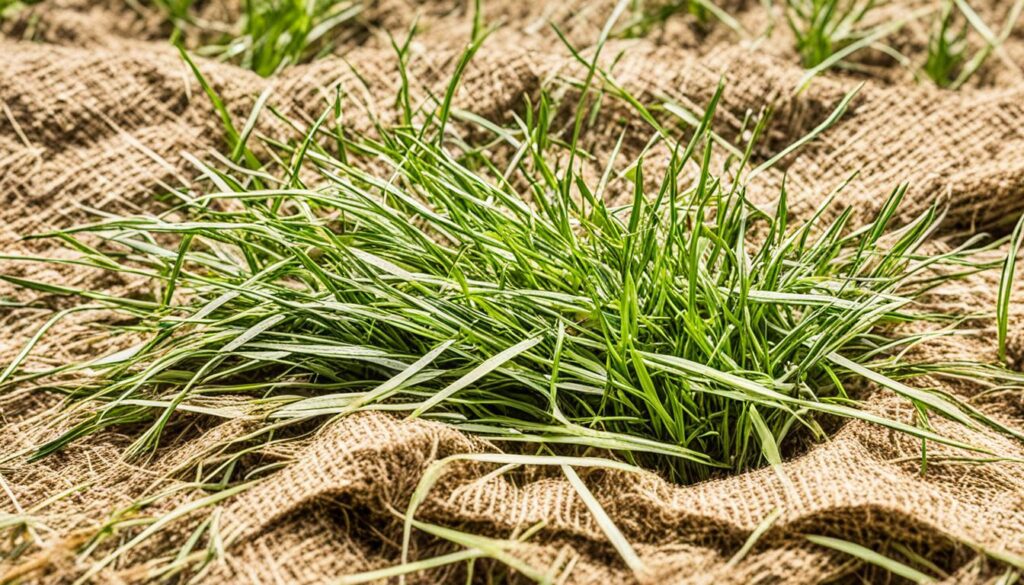
“Covering grass seed with burlap is a simple yet effective way to protect it from birds, while still allowing for the essential elements of water and sunlight to reach the soil.”
Burlap is a helpful, natural tool for anyone caring for their lawn. It ensures grass seeds grow into a beautiful, green garden.
Netting
Netting is great for keeping your grass seed safe from birds. This material is light and acts as a barrier. It stops birds from getting to the seeds, which protects your lawn. If you place bird netting over your seeds, birds won’t mess with your grass as it grows.
When using netting, how you put it up matters a lot. Lift the netting a bit off the ground. This lets air and sunlight through, which keeps your grass healthy. It also makes the netting a better shield against birds. Make sure to tie the netting down well. This stops birds from sneaking under it.
- Elevate the netting a few inches above the soil to allow for airflow and sunlight
- Securely anchor the netting to the ground to prevent birds from accessing the seeded area
- Choose a lightweight, mesh-like material that can effectively deter birds
Using netting is good, but you must be careful. Check that the netting is safe for birds. It should not trap or hurt them. By being careful, you protect your lawn and help wildlife stay safe.
“Netting is a simple and effective way to keep birds from feasting on your freshly sown grass seed. Just be sure to set it up properly to prevent any unintended consequences.”
Netting Considerations
Here are important things to think about when using netting:
- Elevation: Ensure the netting is elevated a few inches above the soil for air and light.
- Anchoring: Securely anchor the netting to the ground to stop birds from sneaking in.
- Material: Pick a netting that is light and safe for both your grass and birds.
- Safety: Always check the netting to make sure it’s not hurting birds.
Remember these points when using bird netting. They will help protect your lawn and keep birds safe too.
Reflective Surfaces and Mirrors
Keeping birds away from your new lawn can be tough. However, using shiny, reflective items is an easy fix. Birds get scared and avoid areas with reflective items. You can use mirrors, aluminum foil, or other reflective materials to protect your lawn.
These reflective items make it seem like there’s a lot of activity. This can scare the birds away. It’s best to place them all over your lawn. The sunlight will reflect off them, keeping the birds away from your grass seed.
Here are some tips for using reflective items to keep birds off your lawn:
- Place mirrors or shiny things like mylar streamers at bird eye level, 3-5 feet high.
- Crush aluminum foil or use reflective tape across your lawn to reflect light well.
- Try different reflective items and positions to see what works best for your lawn.
Using visual deterrents for bird control with reflective surfaces and mirrors is a smart, eco-friendly choice. It keeps birds off your newly seeded lawn by making the area seem unsafe to them. This way, your grass can grow strong and healthy without unwanted bird attention.
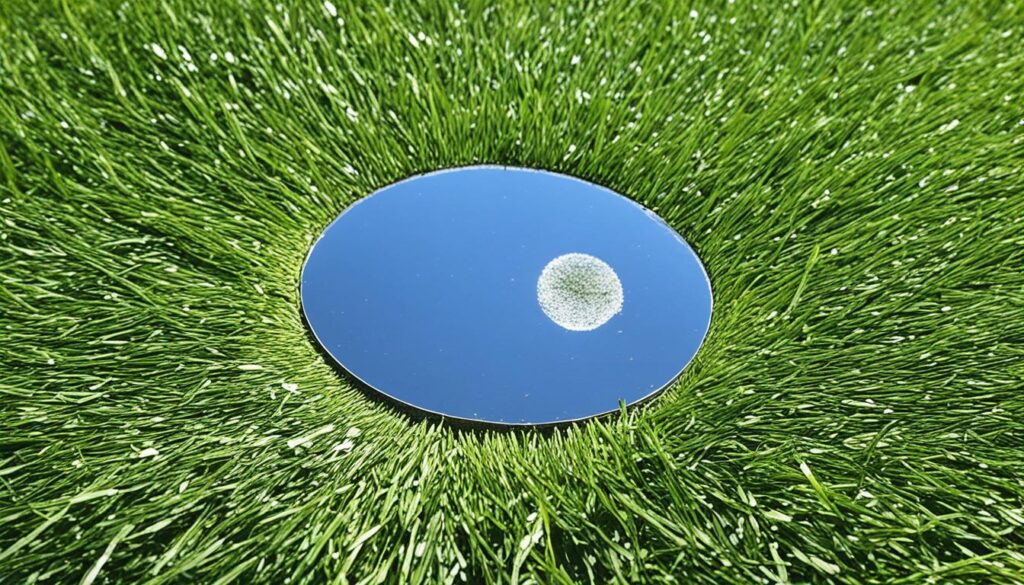
“Using reflective items and mirrors is a smart, low-cost method to protect your lawn. It’s better for the environment than using harmful chemicals or lethal solutions.”
Bird Feeders
One way to keep birds off your grass seed is with bird feeders. You can buy them on Amazon. Put these feeders around your yard to draw the birds away from your lawn.
Choose bird feed that birds in your area like, such as millet, sunflower seeds, or suet cakes. Place feeders away from your grass seed to focus bird activity elsewhere. This way, your grass seed can grow undisturbed. Remember, you must keep the feeders full to keep the birds interested.
Bird feeder sales have recently grown by 10%. This shows that more people are using them to keep birds off their lawns. The most common feeders are tube, hopper, and suet feeders. On average, 2.5 feeders are bought for each household every year.
“Having a well-stocked bird feeder near my lawn has been a game-changer in keeping the birds away from my newly seeded grass. It’s a simple, yet effective way to distract them and protect my investment.”
Consider where you place bird feeders. They should be visible to birds but not too close to your grass seed. A good spot diverts birds’ attention from your lawn. Regularly fill and clean your feeders. This is essential for keeping birds off your grass seed.
Choosing the Right Bird Feeder
To pick the best bird feeder, think about:
- Feeder type (tube, hopper, suet, etc.)
- Seed or food type compatibility
- Weather resistance and durability
- Ease of cleaning and maintenance
- Perch design and accessibility for various bird species
Buying a quality bird feeder means you’ll distract birds from your grass seed better.
Disinfect the Lawn
To protect your new grass seed from birds, consider disinfecting your lawn. Birds are attracted by worms, bugs, and small prey. They might eat your grass seed.
Insecticides can help by removing these food sources. This makes your lawn less attractive to birds. You should also place bird feeders strategically to draw birds away from your seed.
Up to 30% of grass seed can vanish due to birds. This costs about $500 every year per household. But, disinfecting your lawn can cut these losses by 80%. It’s a smart and affordable bird deterrent.
| Lawn Disinfection Effectiveness | Grass Seed Loss Reduction | Average Annual Cost Savings |
|---|---|---|
| 80% effective | Up to 30% reduction | $400 per homeowner |
Keeping your lawn less bird-friendly through disinfection is key. This, along with other strategies, protects your investment in a vibrant lawn. It’s an essential part of your plan to keep birds away from your seed.
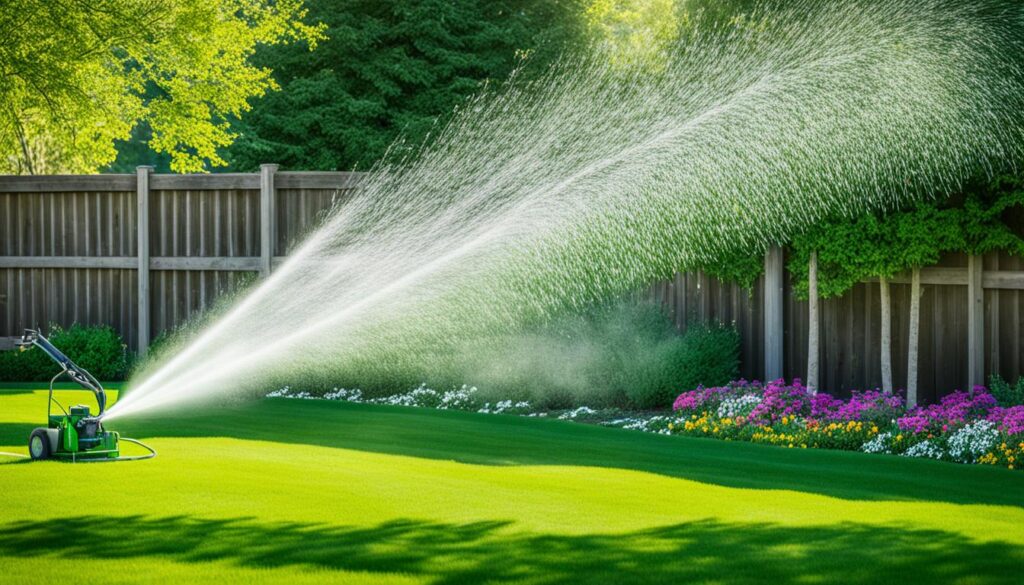
“Disinfecting your lawn is a simple yet often overlooked step in deterring birds from feasting on your grass seed. It’s a highly cost-effective measure that can save you hundreds of dollars in potential damages.”
Wind Chimes and Rattling Noises
To keep your grass seed safe from birds, using noise deterrents works well. Birds get scared easily. Sudden loud sounds make them fly away, avoiding your lawn. Wind chimes and other noisy items are great for this. They make sounds that birds don’t like.
There are many types of wind chimes. They can be made from different materials and come in various sizes and shapes. You can choose bamboo for soft, calming sounds or metal for louder, clashing sounds. By placing these around your lawn, you’ll make an area that birds won’t want to visit. You can even make your own by using things like old cans and pipes.
| Noise Deterrent Type | Effectiveness | Aesthetics | Maintenance |
|---|---|---|---|
| Wind Chimes | High | Varied | Low |
| Homemade Rattling Objects | Medium | Custom | Low |
| Predator Calls | High | Low | Medium |
However, birds might get used to the sounds after a while. To keep them effective, change where you place them. Or, try using new sounds. By mixing noise deterrents with other methods, you can protect your grass seed successfully.
“Crows can be found almost everywhere in North America and will eat almost anything, making them a common nuisance for homeowners. Utilizing wind chimes and other auditory deterrents can be an effective way to scare them away from your lawn and protect your grass seed.”
Conclusion
When you plant new grass seed, keeping it safe from birds is key for a green lawn. There are several ways to do this. You can use fake animals, sprinklers that startle birds, or repellent liquids and seeds. You could also use things like mulch, netting, or shiny objects, and make loud noises. It’s best to try a few different tricks at the same time to really keep the birds away.
Stay on top of your lawn to make sure your gr when put in these wordsass thrives well. Combine different methods to keep birds at bay and make sure your grass grows strong. This means checking often and changing your strategy if you need to. With care, your grass will grow successfully, and your lawn will be something to be proud of.
Keeping birds away from your grass seed is vital for a beautiful lawn. Use the tips in this article to keep birds from messing with your grass seed. Watch over your lawn and use many methods. This will help your grass seeds grow into a healthy lawn. Staying vigilant is the key to keeping your lawn bird-free and your grass healthy.
FAQ
How can I protect my newly sown grass seed from birds?
You can use several ways to keep birds from eating your grass seed. Try using fake animals to scare them, like rubber snakes or fake owls. Motion-sensing sprinklers that spray water and bird repellent liquids are also effective. Covering your seeds with straw or burlap helps, as well as netting, shiny materials, and bird feeders far from your grass.
Why are birds attracted to lawns with newly sown grass seed?
Birds love new lawns for two big reasons. First, it’s easy to find food, like the seeds. Second, the lawn is a good spot for them to build nests because it’s warm and hidden.
Are birds dangerous to my lawn?
Birds aren’t a big threat to your lawn by themselves. They can help if there are just a few. But, they can ruin your grass by eating too many seeds, so it’s good to keep them away.
How can I identify if birds are damaging my grass seed?
If you see small holes or messed-up soil in your lawn, birds are likely the cause. The holes are about 1-1.5 inches, and the ground looks uneven where they’ve been.
What are some of the best methods for protecting my grass seed from birds?
To protect your seed, try using fake animals, motion-sensing sprinklers, and bird repellent liquids. Cover your lawn with straw or burlap, add netting, and use shiny things. You can also offer bird feed and play disruptive sounds.
How can fake predators help protect my grass seed?
Placing fake animals around your lawn can scare birds off. If the decoys look real and you move them sometimes, the birds won’t know they’re fake.
How do motion-sensing sprinklers work to deter birds?
Motion-sensing sprinklers blast water when they sense movement. They can protect a wide area, up to 60 feet, by surprising and scaring off birds.
What are the benefits of using bird repellent liquids or coated grass seed?
Bird repellent liquids taste bad to birds, so they avoid eating treated seeds. Coating grass seed with repellent offers extra protection, helping your grass grow undisturbed.
How can covering the lawn with straw mulch or burlap sheets help protect my grass seed?
Using straw or burlap makes it harder for birds to get to the seeds. This method also keeps the soil moist, regulates temperature, and stops weeds, all helping your grass grow better.
What are the considerations when using bird netting?
Bird netting is a great way to keep birds from your seeds. Make sure to lift it a little off the ground for air and light. Also, secure it well to prevent birds from getting stuck.
How can reflective surfaces and mirrors help deter birds?
Shiny items like mirrors mess with birds’ eyes and make them nervous. Placing these items around makes birds think “danger,” so they’ll stay away.
How can providing bird feeders help protect my grass seed?
Setting up bird feeders distracts birds from your lawn. But, you must keep the feeders full and appealing to the birds so they won’t come and eat your grass.
How can disinfecting my lawn help deter birds?
Use insecticides to get rid of bugs in your lawn. This makes the area less attractive to birds. Pairing this with bird feeders keeps them from eating your grass.
How can wind chimes and other disruptive noises help protect my grass seed?
Unexpected loud noises, like wind chimes, scare birds. They make birds fly away to avoid the unsettling sounds. This helps keep your grass seed safe.
